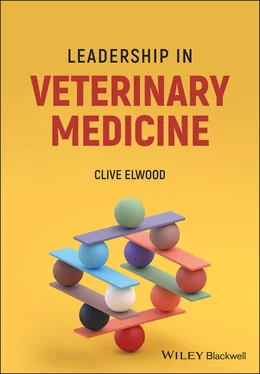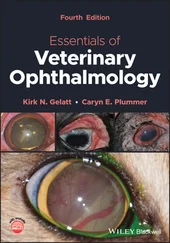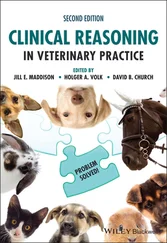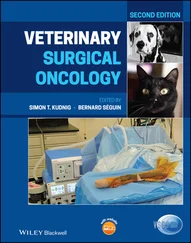Clive Elwood - Leadership in Veterinary Medicine
Здесь есть возможность читать онлайн «Clive Elwood - Leadership in Veterinary Medicine» — ознакомительный отрывок электронной книги совершенно бесплатно, а после прочтения отрывка купить полную версию. В некоторых случаях можно слушать аудио, скачать через торрент в формате fb2 и присутствует краткое содержание. Жанр: unrecognised, на английском языке. Описание произведения, (предисловие) а так же отзывы посетителей доступны на портале библиотеки ЛибКат.
- Название:Leadership in Veterinary Medicine
- Автор:
- Жанр:
- Год:неизвестен
- ISBN:нет данных
- Рейтинг книги:4 / 5. Голосов: 1
-
Избранное:Добавить в избранное
- Отзывы:
-
Ваша оценка:
- 80
- 1
- 2
- 3
- 4
- 5
Leadership in Veterinary Medicine: краткое содержание, описание и аннотация
Предлагаем к чтению аннотацию, описание, краткое содержание или предисловие (зависит от того, что написал сам автор книги «Leadership in Veterinary Medicine»). Если вы не нашли необходимую информацию о книге — напишите в комментариях, мы постараемся отыскать её.
Leadership in Veterinary Medicine
Leadership in Veterinary Medicine
Leadership in Veterinary Medicine — читать онлайн ознакомительный отрывок
Ниже представлен текст книги, разбитый по страницам. Система сохранения места последней прочитанной страницы, позволяет с удобством читать онлайн бесплатно книгу «Leadership in Veterinary Medicine», без необходимости каждый раз заново искать на чём Вы остановились. Поставьте закладку, и сможете в любой момент перейти на страницу, на которой закончили чтение.
Интервал:
Закладка:
Library of Congress Cataloging‐in‐Publication Data Applied for [PB: 9781119749769]
Cover Design: Wiley
Cover Image: © Olemedia/Getty Images
To those we have lost
Acknowledgements
This book has come into being with the input (conscious or otherwise) of many who have my thanks. Firstly, numerous colleagues in the veterinary professions, across a wide spectrum of professional work, have triggered my curiosity and have been a source of insight, challenge, and support. I have been intrigued by what makes us tick and how to make the best of us, and I have unashamedly used both my experiences and those of others as sources of inspiration for some of the scenarios that are presented, whilst changing details to avoid identifiers or any accusations of unfairness. The veterinary professions are full of wonderful people who strive to do good every single day and deserve gratitude and respect. They have mine.
Suzanne Knight, Jo Loach, and Sarah Shepherd started as colleagues and became friends. Together, with many others, they have reminded me that professionalism is not exclusive to the regulated professions and that values, personal and professional, held dearly and expressed with courage, make a difference.
Alison Skipper was a source of insight on how the veterinary context has, and has not, changed over the years. Plus ça change. . . . . I have enjoyed this opportunity to reconnect with a classmate.
Liz Armitage‐Chan stimulates thoughts on professional identity formation and helped me contextualise this in the context of veterinary education.
Alison Lambert routinely challenges my thinking and asks powerful questions, of me and of the veterinary professions. All in the interests of clients, patients and colleagues.
Nuala Summerfield kindly shared her experiences of remote and virtual leadership and helped me contextualise current theory with emerging practise in the veterinary industry.
Stephanie Writer‐Davies gave generous encouragement and feedback as I contemplated this book, as well as showing that relationships, with both colleagues and clients, are the mainstay of practise, where complexity and uncertainty abound, and where every situation and person is different.
Ronan Doyle is a deep thinker who holds and lives his values with dignity, and a wise friend and colleague. Ronan gifted me How Steeple Sinderby Wanderers Won the FA Cup – a gem of a book and the source of the quote in Chapter 9.
Ian Battersby and I have enjoyed many deep, exploratory conversations over the years. I admire his resilience, commitment, and humanity. I am grateful for his forgiveness of my failings, tolerance of my meanderings, and for his constant friendship.
Nat Whitley kindly gave timely comments on the book in progress. He was generous with feedback that, I am certain, improved the final manuscript no end. He is another whose quiet, thoughtful friendship, wisdom, challenge and support is truly valued.
Cheryl Ferguson dealt with my foibles through thorough copy‐editing, and the team at Wiley – Loan Nguyen, Tanya McMullin and Muralidharan Mourthy – put their faith in me and supported me throughout the process.
My wife, Catherine, and my children, Patrick and Rachel, have tolerated my career and the writing of this book. They constantly remind me not to take myself, or life, too seriously, and keep me grounded, whilst giving love and support. I cannot thank them enough. I love them.
And last, but not least, to my writing and thinking companions, Saffi and Fay, who always reminded me when it was time to stop and take them for a walk in the fields.
I am grateful.
Foreword
It is a great pleasure and honour to be invited to write a Foreword for this new and important book on Veterinary leadership. Veterinary leadership is a distinct and important topic within our continuing professional development but has received little attention until recently. This is despite the fact I suspect many of us will have experienced both the positives and negatives that those who lead us can bring to our working lives, impacting not only on the care of our patients and their owners but on the “feel” of our practices and the whole team’s sense of wellbeing – never has this been more important than now.
Leadership can sometimes be characterised purely in the context of organisational leaders with job titles to match, or even more restrictively as “hero leaders” confidently making all the decisions. And yet the truth of leadership, especially in a complex clinical environment, is so much more than that. As vets and nurses, we are all involved with leading others at some point, whether it is leading a client through a difficult decision related to their much loved companion, leading a practice team or providing broader leadership in the profession. The ability to do this, and importantly to enjoy doing this, starts with leading ourselves and Chapter 4provides a great summary of this area.
I have known Clive for many years and cannot think of anyone better to have written this book. His roles as a clinician leader within his speciality of internal medicine and as an organisational leader developing one of the largest referral hospitals in the UK gives him ample experience of leadership at many levels. Ultimately leadership is all about people and his skills as a coach and mentor are well honed. This has resulted in a book which is incredibly accessible for all members of the veterinary team, laced with examples that take the understanding of leadership from academic theory and apply it sensitively and with context to our world.
I know I have enjoyed reading it and I am sure you will to
Amanda Boag MA VetMB DECVECC DACVECC DACVIM FHEA FRCVS
Chief Medical Officer, IVCEvidensia
Scotland August 2021
1 Introduction
1.1 What Is Leadership, and Why Do We Need a Book on Veterinary Leadership?
There are many definitions of leadership, and it is such a fundamental aspect of human existence that we instinctively understand the concept even if writing down a workable definition can be difficult. Here's one of the many definitions I am happy with:
‘Leadership is the function that is devoted to enhancing an organisation's effectiveness.’
– de Haan and Kasozi 2014
By this definition, leadership is not invested in ‘leaders’ but can reside in many people both inside and outside of an organisation. Leadership is a prerequisite of a professional's existence, be it in the service of peers, clients, patients, or society. In addition, this definition implies that leadership exists in an organisational context, which will influence what leadership looks like. As I shall explore in this book, leadership and followership are essential parts of the same function and cannot be examined independently. Leadership is a social process and, together, ‘leaders’ and ‘followers’ construct leadership. Leadership is also a singular, individual, experience; what you see, hear, feel, understand, and respond to as a ‘leader’ will be different to everyone else and will be informed by your own personality and experience. As a complex social interaction, leadership is not easily broken down into ‘how to’ instructions. It is important to remember that when thinking about the issues raised in this book and how they might apply to you and those around you.
Good management is important alongside good leadership, but they are not the same. Good leadership is doing the right things; good management is doing things right ( Table 1.1). The veterinary professions need both leadership and management, but they do not necessarily have to be done by the same people. We may all know good managers who are poor leaders and vice versa. Management is about planning, organising, staffing, controlling activities, and solving problems, (Kotter 1990). Leadership is something different ( Table 1.1).
Читать дальшеИнтервал:
Закладка:
Похожие книги на «Leadership in Veterinary Medicine»
Представляем Вашему вниманию похожие книги на «Leadership in Veterinary Medicine» списком для выбора. Мы отобрали схожую по названию и смыслу литературу в надежде предоставить читателям больше вариантов отыскать новые, интересные, ещё непрочитанные произведения.
Обсуждение, отзывы о книге «Leadership in Veterinary Medicine» и просто собственные мнения читателей. Оставьте ваши комментарии, напишите, что Вы думаете о произведении, его смысле или главных героях. Укажите что конкретно понравилось, а что нет, и почему Вы так считаете.












